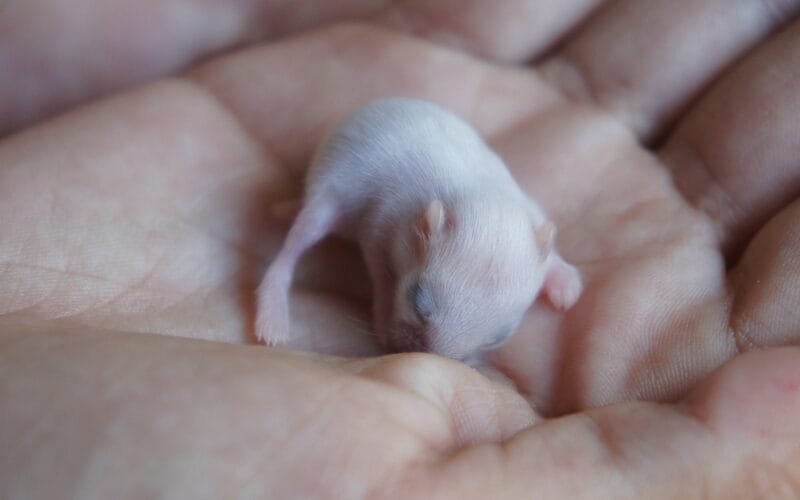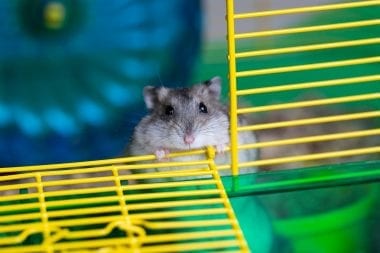Table of Contents Hide
Infant animals are hard to look after. Most animals are born vulnerable and need the constant supervision of their mothers or parents. This is especially true for mammals, which feed milk to their young. This milk contains all the essential nutrients necessary for the infant’s growth and development. Hamsters are no different.
If you have a baby hamster that has sadly lost its mother or has been abandoned by its mother, do not worry. You can help it survive and grow into an adult. Special attention needs to be paid to food, sleeping conditions, temperature and proximity to other creatures. With proper attention and care your baby hamster will thrive.
This may sound very difficult, but the most amount of work would have to be put in for the first 10 to 12 days only. After that the baby will grow some fur and teeth. Then it can chew and feed on its own without you having to put the milk in its mouth. Most pet hamsters mature into adulthood in just 4 to 5 weeks. Your hard work and persistence in raising a baby hamster will pay off once it grows up. As adults, these little rodents make for great pets.
Caring for an Abandoned Baby Hamster
A baby hamster abandoned by its mother will face some difficulties in surviving. Luckily, human intervention can ensure that the baby hamster makes it and grow into a happy adult. Having said that, you need to be very careful and attentive while feeding and rearing a baby hamster.
These are some of the methods you can use to feed and nourish a baby hamster–
Step 1: Feeding with a Needless Syringe
This method is reserved for slightly older hamsters. When the baby hamster is about 2 weeks old, you can use a needless syringe to feed Lactol to it. Lactol is a milk formula, usually given to dogs. Younger hamsters can choke on the milk fed by a syringe as the liquid can directly enter their lungs from the mouth.
To feed with a syringe, pull the baby hamster’s lower lip gently and place the syringe in its mouth. Now carefully push the contents of the syringe into the mouth. To check if the baby wants to drink more milk, put a tiny amount of peanut butter on the tip of the syringe. If the baby licks the butter, it means the hamster is still hungry.
You can even opt to feed a baby hamster mashed food through the syringe. Feeding medicines is also easier with a needless syringe. But be careful. Improper technique with a syringe may result in breathing issues. In extreme cases it can also lead to lung infection and fatal choking. While feeding a baby hamster, pick up and hold it properly in your hands.
Step 1(Option 2): Feeding with an Eyedropper
A much safer method to feed a baby hamster is by using an eyedropper. Once the eyedropper is filled with Lactol, place it above the hamster’s mouth. Now squeeze the dropper gently to release the milk formula drop by drop. The baby hamster will be able to lick it easily, without the risk of choking or infection. Do not squirt the whole formula into its mouth all at once. You may even risk killing the hamster this way.
When you pick up a baby hamster, be very gentle. Never squeeze it. The baby’s body is very fragile and can get easily damaged if you hold it tight. While feeding the hamster, cup your palm over its body to ensure the hamster does not fall. Another feeding option is to wrap a soft towel around the hamster, letting only the head stick out while the paws remain under the towel.
Before squeezing the eyedropper again, make sure that the baby hamster has finished chewing the first drop. Due to their over-sensitivity, an excess rush of liquid into their mouth can easily enter their lungs leading to a fatality. Usually, two drops of the milk formula are enough for one feeding session. This amount will provide enough nourishment to the baby. When the hamster is at least 10 days old, you can start giving it solid food, but in smaller chunks.
Also, be careful with the eyedropper. Hold it firmly and keep it away from the hamster’s face. Otherwise, you could accidently poke its eye and hurt it.
Step 2: Caging the Hamster Comfortably

Image Source
Ensure that the hamster’s cage is comfortable enough to offer good quality rest to the baby. The cage must all the time be dry. Since the baby hamster is so vulnerable, wet or damp bedding can strike it with health hazards like pneumonia. To maintain a state of constant dryness, inspect the bedding regularly and change it if the hamsters have peed in it. Also, place the drinking bowls a safe distance away from the cage. The baby hamster might move around and accidently spill the water in the bowl.
In case water spills inside the cage, you should first carefully remove the hamster. Wrap it in a soft towel or place it inside another dry cage. Use a highly absorbent cloth to soak up any wetness in the cage. For bedding, tissue paper is a good option. They are cheap and easy to replace. Other choices include cotton pads and kitchen rolls.
When you make the bedding (or nest) for the hamsters, ensure that it is comfortable and warm. Babies spend a majority of their first 10 to 12 days in the nest. This is a source of warmth to them. Usually, the mother hamster provides that warmth. To add a little extra heat, you can put a heating pad right under the hamster cage.
While handling baby hamsters, always wear gloves. You do not want to rub your scent on them. Always have gloves on while holding, transporting or feeding the babies. Wear gloves when cleaning their cage as well. You should aim for at least one cleaning session every week.
Step 3: Keeping the Hamster Safe from Animals
You must not mix a baby hamster with other animals. In their infancy, hamsters are prone to life-threatening damage. Other animals can intentionally or accidentally cause harm to the baby hamster. A baby is completely defenseless and vulnerable to attack. Even loud noises made by other animals can traumatize them, causing distress and impairment. For their protection, distancing them from plausible threats is crucial.
You may choose to keep multiple baby hamsters together in a single cage. But that will only work for the initial 3 to 4 weeks. Due to their solitary nature, hamsters do not like sharing their space with others (even if it is the same species). They may turn aggressive towards each other and injure themselves in a fight. Within 20 to 28 days after their birth, hamsters become sexually active. So it is wise to separate the males and females, unless you want them to start mating.
If you really want to keep multiple hamsters in the same cage, take some precautions. First, get a large cage which will give each hamster enough space to move and select their own territory. Second, keep fewer hamsters in one cage, so they do not fight for area. Third, as mentioned earlier, keep hamsters of the same sex in the same space (unless you want more baby hamsters).
Step 4: Food Instructions
A baby hamster should never be fed overheated food. Hot food can seriously damage the internal organs of a hamster between 1 and 2 weeks old. Their throats can get affected, which may impair their ability to chew properly as adults. In extreme cases, hot food can cause swelling in their gums and food pipe.
Damaged internal organs greatly reduce a baby hamster’s ability to digest food. Without proper digestion, the hamster will become malnourished and even die. The right temperature for the food is 90 degrees Fahrenheit (ca. 32 °C). Use the stove to heat the food instead of a microwave as it can result in uneven heating. The best food for a baby hamster is the milk formula, Lactol. This formula is comparable to the mother hamster’s milk in terms of nutrition and purity. Normal milk can upset a baby’s stomach and may even lead to diarrhea.
Step 5: Maintaining the Temperature of the Room
Baby hamsters are not born with a fur. As a result, they have no protection against heat and cold due to a lack of body temperature regulation. Therefore, you should take efforts to maintain the cage temperature around 70 degrees Fahrenheit (ca. 21 °C). Partially covering the baby hamsters in their nest will keep them warm. If it is winter time, or generally cold, use a heating pad. Place it under the cage to provide warmth. Set the temperature of your air conditioner to 70 degrees Fahrenheit (ca. 21 °C) to maintain a consistent cozy temperature.
Never assume the cage temperature. Use a thermometer to check the temperature of your hamster’s cage. Ensure that it is ideal. If it is too cold or too hot for the hamster, it can die.







